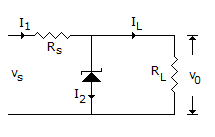ECE :: Analog Electronics
-
Which of the amplifier circuits using junction transistors has the best gain?
-
To obtain very high input and O/P impedance in a feedback amplifier, the type of feedback utilized
-
Oscillator with best frequency stability is
-
The IF amplifier in a superheterodyne receiver is
-
Examine the circuit of figure and the following statements

- Vs is more than the zener breakdown voltage.
- IL = I1 - I2.
- Rs is less than zener nominal resistance.
-
The approximate value of input impedance of CE amplifier with emitter resistance RE is given by
-
The advantage of using crystal oscillator is that it
-
A transistor will operate in inverted region when
-
Cross-over distortion behaviour is a characteristic of


 Whatsapp
Whatsapp
 Facebook
Facebook

